1 – Teamwork
Standards and the elusive nature of artwork
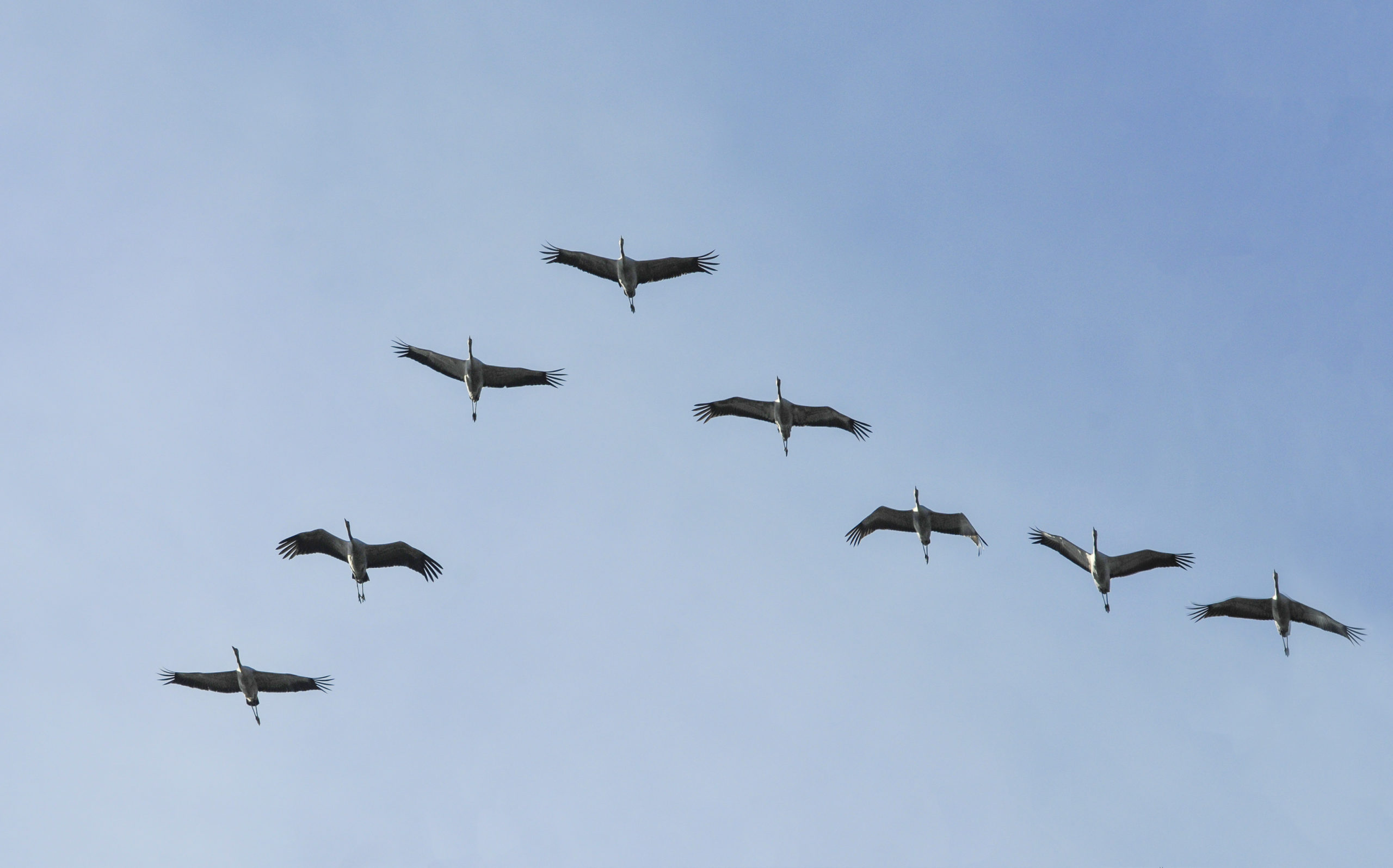
Common Crane Grus grus Extremadura, Spain 1 March 2015 (René Pop)
I have big ideas. Many people do. The issue with bird songs is always, how can you get them out into a state where thoughts about how and why they are produced are clearly communicated? There are folk out there who, through hard work and careful editing, can do that alone. I am not one of them. I always work within teams.
Let’s get one thing out of the way straight off. It’s not ‘my’ team. For convenience it can be called that but it’s more like a flock, each taking turns to look out for danger. As in cranes, each member in turn can take the lead until exhausted when it heads to the back and enjoys the slipstream of the others.
The first rule of teamwork is approaching the right people. I’m not particularly good at that either. I muddle along, talking to this person, gossiping and enthusing and looking for points of similarity until the conversations reach a point where action takes over. It takes time – years, not hours – as trust develops, and it’s nearly always based as much on sharing a sense of humour.
Each team has its own rules. One of the Sound Approach rules was first suggested by Arnoud when we were working on The Sound Approach to birding. This is how the conversation went: “Arnoud, this is going to take a little longer than I first thought” … then after a moment’s silence the reply; “Will extra time improve the end result?” “Yes I think so. I still haven’t got to a conclusion…” “OK, as long as it is improving”.
At The Sound Approach we all share Arnoud’s wish for a quality product. There are times when I think that’s all we have in common… a love of a job well done.
Take this example, and the other articles we plan in this series. Yes I’ll have written the texts but Magnus will have made sense of them, found examples to illustrate the points and mainly talked me to a point where I haven’t made a complete cock of myself by suggesting something that, due to my ignorance, just doesn’t stand up to scrutiny. Arnoud edits and rearranges them scientifically. It is a great pleasure to work with the Sound Approach.
For Magnus, Arnoud and me it is relatively straightforward. We all record bird sounds and put our initials in the reference numbers, and when we work on each other’s projects we use “The Sound Approach” as a signature. Killian has a different situation. Each figure on each plate takes an age to do, and there is no team to fall back on. Kipling summed up Killian’s situation far better than I can in his poem When Earth’s Last Picture Is Painted:
“…And only the Master shall praise us.
And only the Master shall blame.
And no one will work for the money.
No one will work for the fame.
But each for the joy of the working,
And each, in his separate star,
Will draw the thing as he sees it.
For the God of things as they are!”
When, unexpectedly, I read this to Killian over the phone it caught him off guard. “Bloody hell Mark, you need to give me a warning if you’re going to spring something like that on me” he replied, his voice catching with emotion. In the end no doubt, those working for money or fame could do a quicker job but painting things as you see them is a bit trickier, especially when you aren’t sure exactly how they are.
So for example the 16 plates in Petrels night and day, which came out in 2008, took Killian 2 years to paint. In my experience ten plates in a year is Killian at full speed. The work is brilliant and for those of us used to his high standards well worth the wait but Killian gets frustrated, so we talked about teamwork.
I had watched an interview with Hergé the illustrator of Tin Tin. In order to be more productive and make the most of Tin Tin’s popularity he started Hergé studios, where a series of apprentices and colourists speeded up production. “Perhaps we should start Mullarney studios”, I said. In the end, in 2012 we tried an experiment when Killian recruited talented wildlife artist Richard Johnson.
They decided to try a few plates together, Killian producing a detailed layout with dedicated captions and Richard painting the figures in watercolour. The aim was also to create a lighter, more sketched appearance. Here is an example of their collaboration on a plate of Baird’s Sandpiper Calidris bairdii. First, Killian’s ghostly initial illustration followed by Richard’s painted plate. Then as all good fathers should, Killian frets over it until he gives the final OK. Having the confidence to publish the work when finally approved is another thing. These were completed at the end of 2013, to give perspective to the slow nature of whole project.
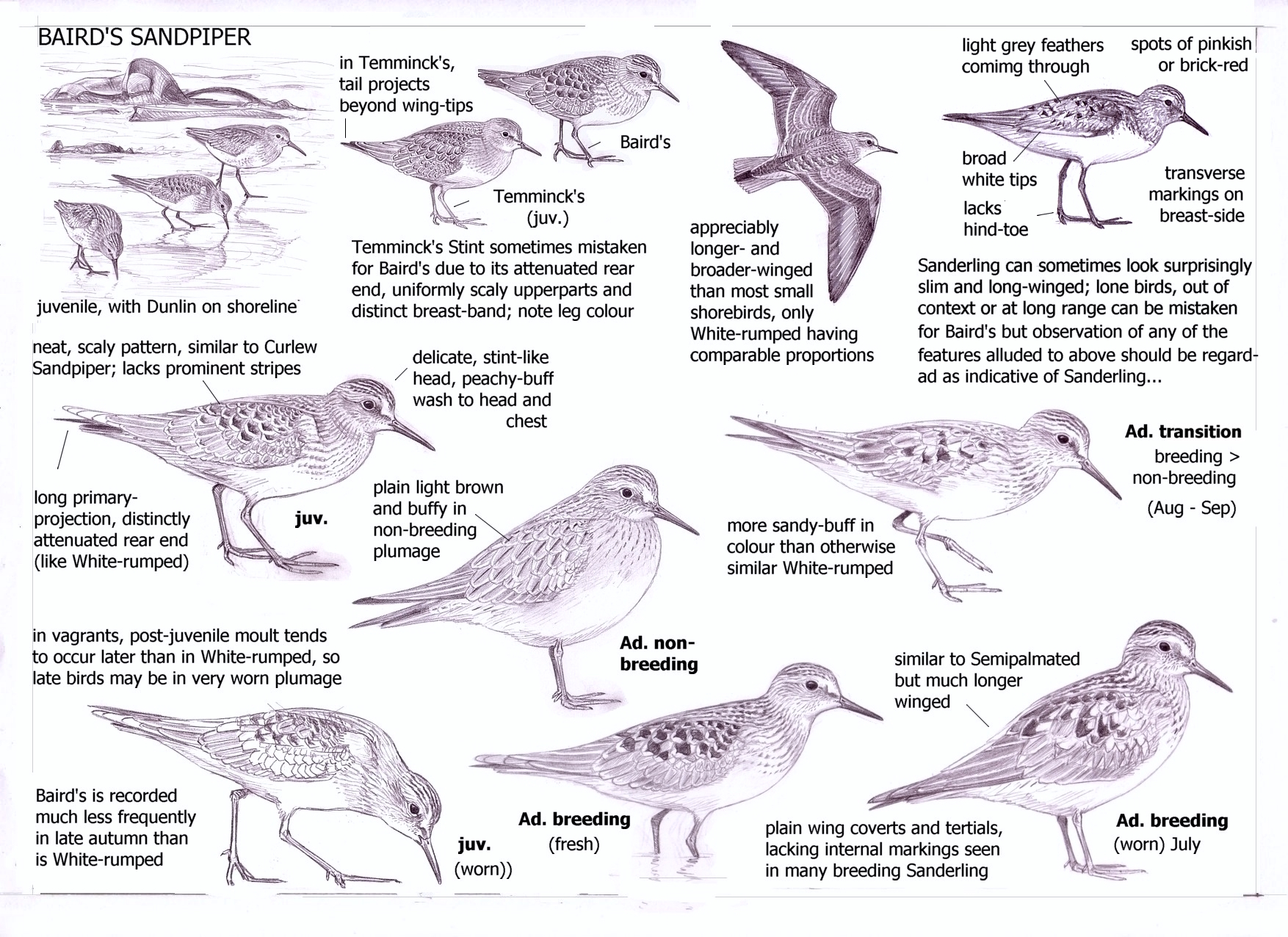
Sketch for Baird’s Sandpiper Calidris bairdii plate (Killian Mullarney).
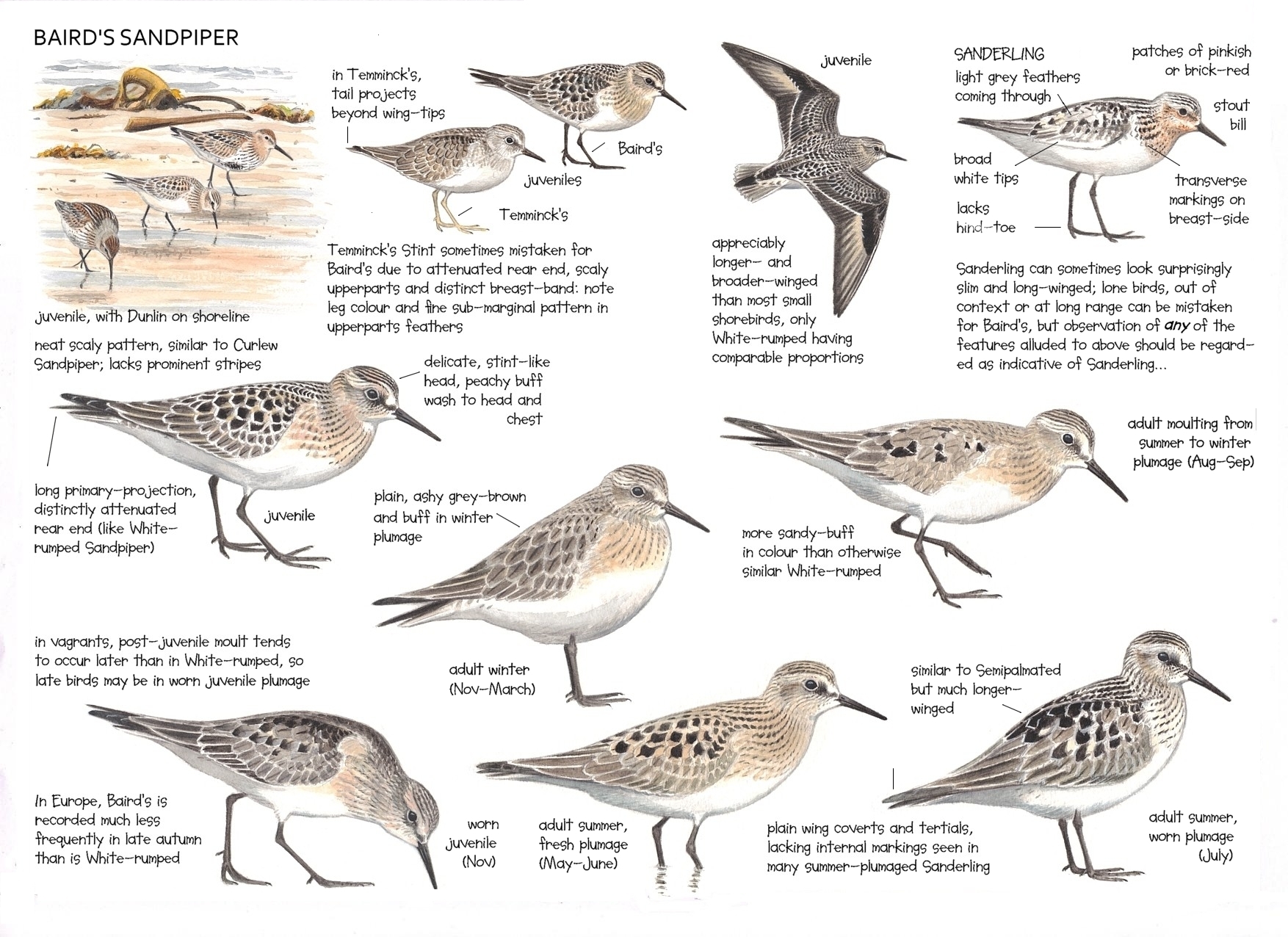
Baird’s Sandpiper Calidris bairdii plate (Killian Mullarney & Richard Johnson).
The Sound Approach team has made over 70,000 recordings of mainly Western Palearctic birds, each with its own full description held in one database. Recently, just to prove how really nerdy we are, I started to post a “tweet of the day”. While this had been done before by the BBC, ours was of a bird sound recorded on that actual calendar date at some point in the past twenty years, often accompanied by a photograph of the bird itself, or one made on or close to the same date.
Describing bird sounds has a lot in common with describing wines or a fragrance: most of us just don’t have the words. That’s where a sonagram comes in handy. Our ears may deceive us, but when we bring our trusty eyes into focus we know better where we are.
In our collection we have recordings from Baird’s Sandpiper’s breeding grounds in Canada. Magnus recorded them in the Inuit territory of Nanavut in June 2016. In addition, we have recorded four vagrants; two that Killian recorded at Tacumshin near Wexford, Ireland, one that Arnoud recorded in the Netherlands and another recorded by Magnus in Poland. To complement the illustrations let’s explore these sounds.
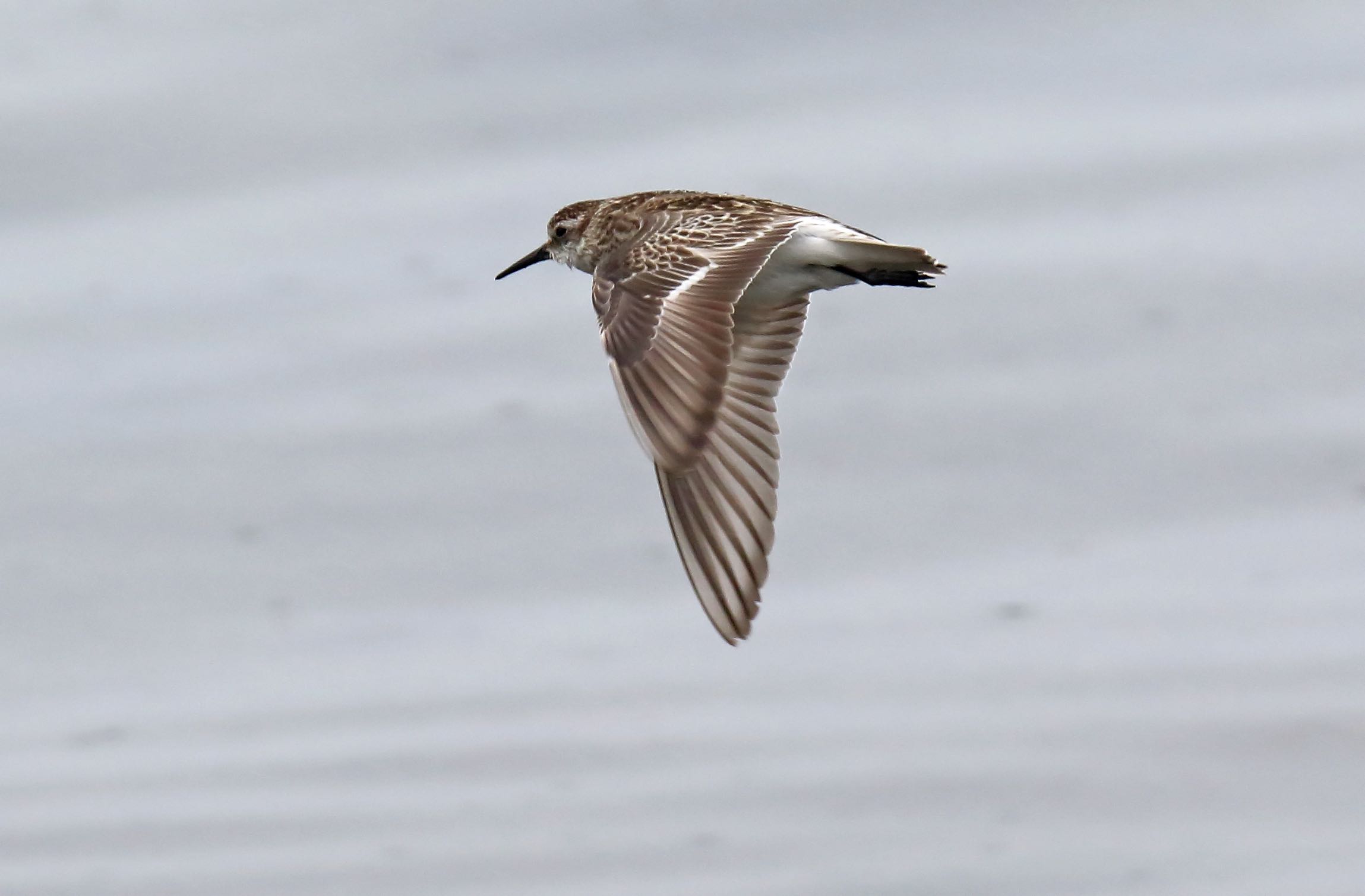
Baird’s Sandpiper Calidris bairdii Chiloé, Los Lagos Region, Chile, October 2015 (Daniel López-Velasco)
Flight calls, flying past the observer. In our examples, all of single birds, thecalls are well-spaced. We can assume that the nocturnal flight call of Baird’s Sandpiper is similar to these.

Baird’s Sandpiper Calidris bairdii Tacumshin, Wexford, Ireland, 10 September 2004 (Killian Mullarney). Two calls of a juvenile flying past. 04.005.KM.01222.10
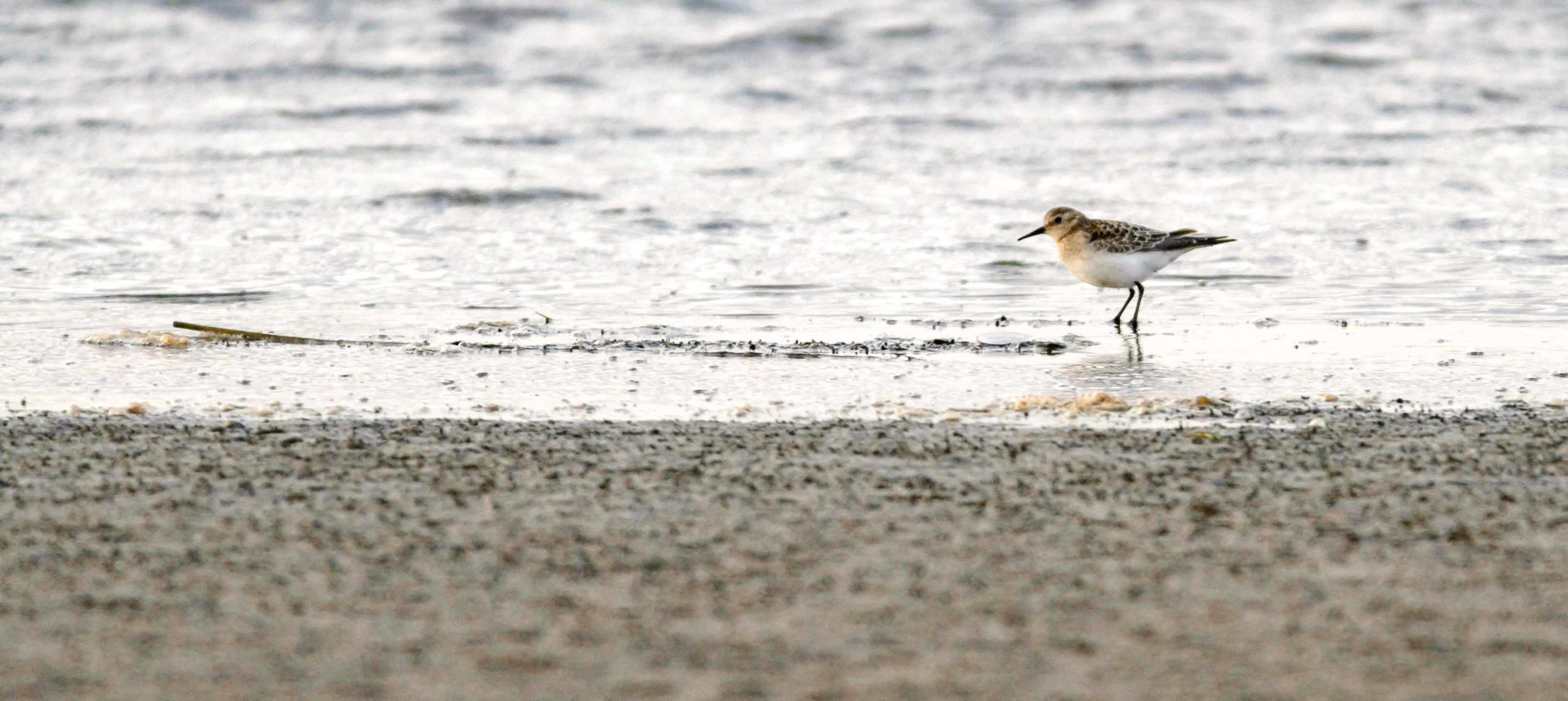
Baird’s Sandpiper Calidris bairdii Tacumshin, Wexford, Ireland, 16 October 2011 (Killian Mullarney). This is the bird in the recording below.
Baird’s Sandpiper Calidris bairdii Tacumshin, Wexford, Ireland, 16 October 2011 (Killian Mullarney). This is actually a recording of the bird in the photo above taking off, but it calls as if it is flying past calmly. 111016.KM.164632.12
Calls when flushed. As with many waders, the first calls when flushed tend to be clustered close together before becoming more spaced out and relaxed, as the bird moves further away. It’s easy to make mistakes when only hearing calls given on take-off. In Arnoud’s recording the calls sound harsher and perhaps more stressed.

Baird’s Sandpiper Calidris bairdii Wassenaar, Zuid-Holland, Netherlands, 15:38, 29 August 2012 (Arnoud B van den Berg). Calls of a juvenile when flushed. 120829.AB.153809.11

Baird’s Sandpiper Calidris bairdii Tacumshin, Wexford, Ireland, 10 September 2004 (Killian Mullarney). Calls of a juvenile when flushed, with quiet calls of Dunlin C alpina. 04.003.KM.13800.00
A couple of more calls of the same 2004 Tacumshin bird taking off, then becoming more relaxed in continued flight.
Baird’s Sandpiper Calidris bairdii Tacumshin, Wexford, Ireland, 10 September 2004 (Killian Mullarney). Calls when flushed, then in continued flight. Also a flight call of Dunlin C alpina and several quiet calls of Common Ringed Plover Charadrius hiaticula. 04.003.KM.14057.00
Baird’s Sandpiper Calidris bairdii Tacumshin, Wexford, Ireland, 10 September 2004 (Killian Mullarney). A juvenile taking off with Common Ringed Plovers Charadrius hiaticula. 04.003.KM.14239.00
A pitfall: if you think you can hear a Baird’s Sandpiper flight calls, especially in a nocmig recording, remember to exclude the possibility of a juvenile Sandwich Tern Sterna sandvicensis. Here is a recording made by Paul Morton that illustrates this perfectly.
Sandwich Tern Sterna sandvicensis Poole, Dorset, England, 01:31, 25 August 2016 (Paul Morton). Sandpiper-like flight calls of a juvenile migrating at night, with a cheeky Ortolan Emberiza hortulana ‘bombing’ the recording.

Baird’s Sandpiper Calidris bairdii Wassenaar, Zuid-Holland, Netherlands, 29 August 2012 (Arnoud B van den Berg).
Alarm calls of Baird’s Sandpiper are rather distinctively long, unlike other Calidris, and they are used frequently outside the breeding season. Here is an alarm call from the Dutch bird in the photos above, a juvenile.

Baird’s Sandpiper Calidris bairdii Wassenaar, Zuid-Holland, Netherlands, 17:47, 29 August 2012 (Arnoud B van den Berg). Alarm call of a juvenile. 120829.AB.174700.21
Adult alarm calls. Adult alarms are basically the same as juvenile ones. In our examples they are lower-pitched, but we do not know if this is consistent. They can be delivered singly or doubled:
Baird’s Sandpiper Calidris bairdii Victoria Island, Nunavut, Canada, 21:03, 21 June 2016 (Magnus Robb). Single-note alarm calls of an adult. Background: Cackling Goose Branta hutchinsii. 160621.MR.210326.21
Baird’s Sandpiper Calidris bairdii Victoria Island, Nunavut, Canada, 01:39, 23 June 2016 (Magnus Robb). Alarm calls of an adult, including many that are doubled. Background: Cackling Goose Branta hutchinsii, Sandhill Crane Antigone canadensis and Lapland Longspur Calcarius lapponicus. 160623.MR.013921.01
Adult flight (& alarm) calls. Note that adult flight calls seem to be more dry-sounding than in juveniles. Look at the very tidy structure of the calls with a clear separation between each element of the trill. Juvenile calls sound rather slurred by comparison.

Baird’s Sandpiper Calidris bairdii Victoria Island, Nunavut, Canada, 01:41, 23 June 2016 (Magnus Robb). Flight calls and alarm calls of an adult. Background: Cackling Goose Branta hutchinsiiand Lapland Longspur Calcarius lapponicus. 160623.MR.014100.10
A common source of confusion is to hear a fragment of song of a wader outside its breeding grounds – Magnus recorded a brief snatch (<2 sec) from a first year Baird’s in Poland in autumn. Sadly, the quality was too poor for inclusion here. Instead, here are some examples of fully developed songs from the breeding grounds in Canada.
Baird’s Sandpiper Calidris bairdii Victoria Island, Nunavut, Canada, 12:43, 23 June 2016 (Magnus Robb). Flight calls and song of an adult. Background: Lapland Longspur Calcarius lapponicus. 160623.MR.124316.01
Baird’s Sandpiper Calidris bairdii Victoria Island, Nunavut, Canada, 03:00, 24 June 2016 (Magnus Robb). Song briefly, passing right over the microphones. Background: Cackling Goose Branta hutchinsii and Lapland Longspur Calcarius lapponicus. 160624.MR.030006.00


Baird’s Sandpiper Calidris bairdii Victoria Island, Nunavut, Canada, 02:52, 24 June 2016 (Magnus Robb). A long recording including the two main types of song. Both sonagrams above are from this recording. Background: White-fronted Goose Anser albifrons, Cackling Goose Branta hutchinsii, King Eider Somateria spectabilis, Semipalmated Plover Charadrius semipalmatus, Pectoral Sandpiper C melanotos and Lapland Longspur Calcarius lapponicus. 160624.MR.025213.01
Flight calls of Baird’s Sandpiper, Curlew Sandpiper C ferruginea and Pectoral Sandpiper C melanotos used through the greater part of the year are rather similar. All three have modulated note or trill with the main energy between 2-3 kHz. The main differences concern the depth of the modulations, and the overall inflection of the call. Length may also be a useful pointer.
Calls of juvenile Baird’s Sandpiper, the type we are most likely to hear in Europe, are slightly shorter than in the other two species on average. They have relatively shallow modulations, sounding a little slurred, and there is little if any noticeable change in pitch during the course of the call.
Baird’s Sandpiper Calidris bairdii Tacumshin, Wexford, Ireland, 10 September 2004 (Killian Mullarney). Four more relaxed calls shortly after taking off. 04.003.KM.13848.00
The most useful characteristic for Curlew Sandpiper flight calls is that the pitch is not even. The call rises subtly towards the end, but often there is also a slight drop right at the start of the call, immediately after first element of the trill. Curlew Sandpiper has slightly longer calls than Baird’s on average, with more of a musical, trilled sound: there is a greater degree of separation between the elements. At times it can actually sound a little reminiscent of Snow Bunting Plectrophenax nivalis flight calls.

Curlew Sandpiper Calidris ferruginea Shannah, Ash Sharqiyah South, Oman, 22 April 2010 (Magnus Robb). Flight calls of a small flock during the spring migration. 100422.MR.075136.00
Pectoral Sandpiper has calls that sound noticeably harsher than those of the other two species, which is due to having deeper and more irregular modulations. It also sounds a little low-pitched, although the main energy is concentrated at only a very slightly lower pitch than in the other two species. Perhaps the main deeper modulations contribute to this impression. Unlike Curlew Sandpiper it does not show any noticeable change in pitch during each call. Note that during the breeding season and for a very short time afterwards, males have flight calls that are very different, and do not resemble Baird’s Sandpiper at all.

Pectoral Sandpiper Calidris melanotos Tacumshin, Wexford, Ireland, 1 September 2003 (Killian Mullarney). Flight calls of a juvenile. 03.013.KM.02110.11
So that’s our team effort. In the end what binds a team is the pleasure of the work and this has been a pleasure.